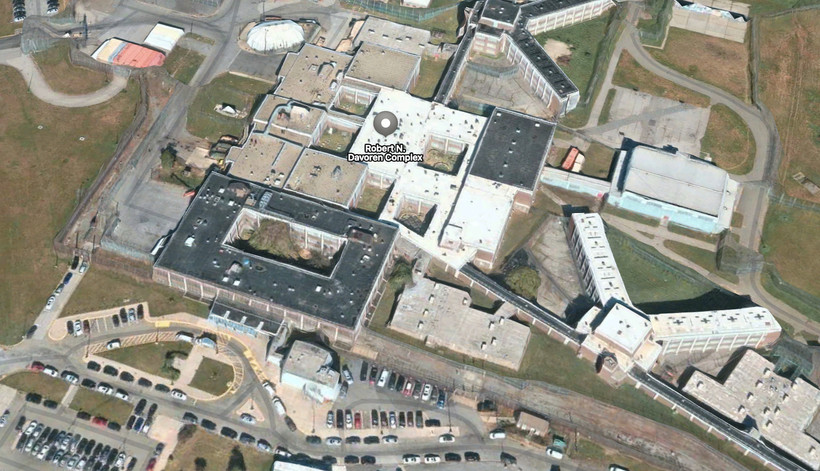I Know What It Means to Strike at Rikers
I helped organize a strike at Rikers during the first wave. Those striking now are not to be ignored.

This article was published in our Perspectives section. David Campbell is a writer and anti-fascist activist who helped organize a strike while incarcerated at Rikers Island in 2020.
Two days ago, I read that there was a massive strike underway at Rikers Island. It brought back a flood of memories—dingy, scuffed white walls, clanging metal doors, a near-total dearth of comfort or privacy, and, perhaps strangely, a sense of solidarity so strong it moves me still.
In March of 2020, I was a prisoner in the Robert N. Davoren Center on Rikers Island. All my clothes were forest green. My bedsheets were stamped “DOC” in block letters. My neighbor on one side was a Dominican-American crack dealer with an imposing stature and infectious laugh; on the other, a tall, gaunt heroin addict from the Caucasus who I gave English lessons to two or three times a week.
The men in my 48-bed dorm all had their petty beefs and claims to a place on the totem pole. Who controlled the TV, who could use what phone, who was first in line for chow–these things take on oversized importance in jail. But all that changed when the pandemic hit. The Department of Correction seemed like it was trying to win a prize for most-bungled Covid response: It refused to take any serious attempt at mitigating the spread of the disease, testing for its presence, or social distancing, even as it claimed publicly that everything was under control. The extent of the response was to slap up posters advising us to social distance–a physically impossible feat–in twelve different languages. We were offered the most nonsensical advice to ward off Covid, like “drink green tea.”
After a week of mounting frustration at the DOC’s hypocrisy, they cut off our phones for several hours one morning. The phones are a lifeline in jail. They’re the only direct method of communication with the outside world. The reason, we were told, was to encourage us to clean our dorm. In fact, we had organized ourselves into cleaning crews, schedules and all, to make up for the fact that the institution was not taking any measures to protect us. This was the spark that lit the fire, and we went on strike. Suddenly, the fact that we all wore forest green and had DOC-stamped bedsheets mattered more than our backgrounds, convictions, or gang affiliations.
With near-unanimity, we refused to leave the dorms for work or institutional meals. When the phones came back on briefly, I communicated a list of grievances and demands to an activist friend on the outside, who spread the word on social media. We wanted masks, Covid tests, and cleaning supplies, and the immediate release of as many prisoners as possible, measures the Board of Correction had called for only days earlier. Prisoners on Rikers often share food and other scarce resources with each other, but once we went on strike, this practice became something else altogether. Volunteers began soliciting donations from among us and cooking giant collective meals. Though disputes still arose, they seemed less frequent and less frivolous.
Now, prisoners in RNDC are striking again. Our strike numbered about 90 and lasted one day. Theirs numbers 200 and has now gone on for seven. Their claims of being denied access to medical and mental health care, outdoor exercise, law library services, and humane living conditions are all entirely believable—I witnessed all of them first hand during my time there.
This sort of refusal to comply is called a “stick-up” in Rikers lingo. A stick-up may not be an organized strike. A prisoner refusing to exchange his sneakers for the painfully thin DOC-issued shoes upon arrival, or refusing to allow himself to be transferred to another housing unit, for example, would be considered sticking it up. Sticking it up also refers to a broad range of less-than-noble goals and tactics; splashing a guard with urine because you haven’t been brought new video games in two weeks, for example.
But the sort of action underway at RNDC happens way more than you might think—it just tends to go unreported. One reason is simply because it’s less splashy. Stories of violence tend to grab attention. Another is that many of those incarcerated have no way to get word to the outside about their actions. Many, sadly, have no one to call. They often give away their phone calls, or sell them to other prisoners for things like ramen noodles or potato chips.
Nor do most have a frame of reference for strategic activism. Even after we had established a broad consensus to go on strike, for example, many of my fellow prisoners asked me what the point was. Striking prisoners may never think of themselves as “on strike” or communicate their actions to the outside world, let alone with a clear list of demands and grievances.
But within the walls, sticking it up is a fairly common occurrence. On Christmas Eve when I was incarcerated, the guards tried to pass my dorm over for its regularly scheduled commissary trip (the DOC is incredibly disorganized, and prisoners’ basic needs often go unfulfilled as a result). The gang members in my dorm led the charge and quickly placed themselves between the guard on his way out of the room and the gate, refusing to budge until we were all taken to commissary. It was the first stick-up I’d seen, and it worked.
I also heard several firsthand accounts from different sources during my time inside of a sit-down for racial justice in “the Five,” or the Anna M. Kross Center, another building on the island. One of the regularly scheduled officers at the housing unit in question was apparently widely disliked for constantly berating the inmates with racist remarks. The final straw came when she took a cheap shot at an inmate of Middle Eastern descent, cracking off a comment about terrorism. The Latin Kings, who ran the cellblock, convinced everyone to pack their belongings into trash bags, sit down on the floor, and refuse to move until the higher-ups were called. They were, and the offending officer was rotated to another post.
It’s incredibly difficult to pass information in jail; the sit-down had happened during my sentence, but I only heard about it months later, when one of the participants was transferred into my dorm. A great deal of things are communicated by yelling out the windows, but this is an imperfect method, to say the least, especially when you can’t see the other person. My dorm and the other dorm on our floor went on strike together because we could communicate through the air vents. The dorms upstairs, however, never got on board. I later learned from guys who had been housed there at the time that they would have gladly joined in, if only they had known.
When information does spread, though, it can be powerful. When we went on strike in March 2020, we were inspired in part by reports a fellow inmate’s girlfriend had seen on Twitter that prisoners in the Hudson County Immigrant Detention Center were on hunger strike, which she then reported to him over the phone. A few days prior, another guy had spread the word that his partner had told him during a phone call that inmates were “wil’in’ out in the Five” in protest of Covid conditions, a fact I believe also contributed to our later decision to strike.
Prisoners, according to the DOC’s inmate handbook, do not have the right to organize protests of any kind. Beyond any official sanctions, the organizers—especially those brave enough to speak out to the media using their names—can be punished with time in solitary confinement or extensions of their sentence on Rikers, as well as unofficial forms of retribution.
When a number of prisoners flat-out refused to bury the unclaimed Covid dead on nearby Hart Island without personal protective equipment, they lost their “good time” (that is, time taken off of their sentence for good behavior) and were transferred en masse for their trouble. In August 2020, prisoners’ wages were drastically slashed, and a number of those in my dorm were simultaneously assigned the difficult job of cleaning the holding pens in the bowels of the New York City courts, which entails waking up at 5am only to be shackled and driven across town six days a week. Most stuck it up, and when I left the island in October of that year, they were still striking, racking up expensive infraction tickets and living under the threat of losing good time.
Other forms of retaliation are more subtle. Searches, for example, are used as a tool to repress prisoners’ ability to organize: even if they aren’t actually looking for anything, DOC staff can arrive at any moment, strip-search you, and trash your few belongings, often confiscating a seemingly random assortment of items in the process. A transfer to another housing unit, too, can be a vicious act of retribution. Imagine someone appearing in your bedroom and ordering you to throw everything you own into a trash bag within the next ten minutes; then spending somewhere between a few hours and a few weeks in a holding cell without a bed or possibly even running water or a flushing toilet, amid a constant flow of stressed-out new arrivals and forced transferees like yourself; and finally arriving in a housing unit where you may not know anyone, and where you’ll likely be forced to take the most uncomfortable bed, or, in some cases, jumped in.
Those of us who went on strike in March 2020 were comparatively fortunate in this regard. The DOC hierarchy had planned to transfer us all to different housing units as a way to punish us and break our momentum, but that never materialized. Many of the strikers were actually released by the DOC in the two days that followed the strike, and in the turmoil of the first wave, those of us left behind were not targeted for retaliation by the institution.
The most frustrating thing for me is that most of the men currently on Rikers could be immediately released too, and it would pose no problem to anyone. Three-quarters of the men I was locked up with were released overnight in the wake of our strike, part of an ultimate total of 1,477 people released during the first wave of the pandemic. Four months later, only 13% of those men had been rearrested. I think of those brave strikers in the building I was forced to call home not long ago, and I can only hope they are as successful.


